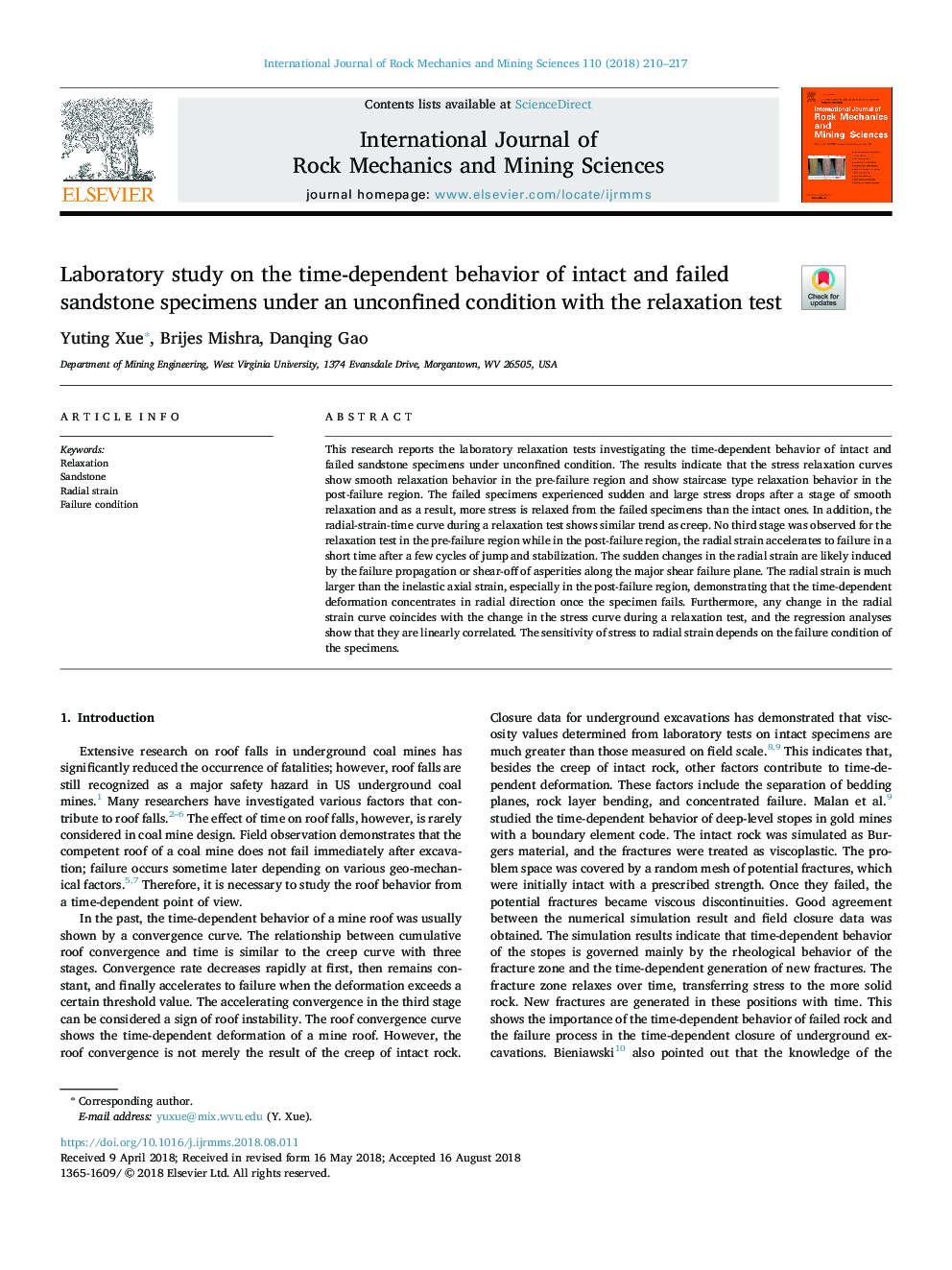| کد مقاله | کد نشریه | سال انتشار | مقاله انگلیسی | نسخه تمام متن |
|---|---|---|---|---|
| 11004159 | 1468659 | 2018 | 8 صفحه PDF | دانلود رایگان |
عنوان انگلیسی مقاله ISI
Laboratory study on the time-dependent behavior of intact and failed sandstone specimens under an unconfined condition with the relaxation test
ترجمه فارسی عنوان
مطالعه آزمایشگاهی در مورد رفتار وابسته به زمان نمونه های مصنوعی و ماسه سنگی تحت شرایط غیرقابل کنترل با آزمون آرام سازی
دانلود مقاله + سفارش ترجمه
دانلود مقاله ISI انگلیسی
رایگان برای ایرانیان
کلمات کلیدی
آرامش ماسه سنگ، فشار شعاعی، وضعیت شکست
ترجمه چکیده
این تحقیق، آزمایشهای آرامش آزمایشگاهی را برای بررسی رفتار وابسته به زمان نمونه هایی از ماسه سنگ مصنوعی و شکست خورده تحت شرایط غیرقابل کنترل گزارش می دهد. نتایج نشان می دهد که منحنی های آرامش استرس نشان می دهد رفتار آرامش صاف در منطقه پیش از شکست و نشان دادن رفتار آرام سازی نوع پله در منطقه پس از شکست است. نمونه های شکست خورده پس از یک مرحله آرام شدن صاف، ناگهان و شدید استرس را از بین می برد و در نتیجه، استرس بیشتری از نمونه های شکست خورده از نمونه های ناموفق کاهش می یابد. علاوه بر این، منحنی زمان شعاعی-فشار زمان در طی یک آزمایش آرامشی روند مشابهی را به عنوان خزش نشان می دهد. هیچ مرحله سوم برای آزمایش آرام سازی در منطقه پیش از شکست مشاهده نشد، در حالی که در ناحیه پس از شکست، کشش شعاعی در زمان کوتاهی پس از چند دوره پرش و تثبیت، شتاب می گیرد. تغییرات ناگهانی در فشار شعاعی به احتمال زیاد ناشی از انتشار شکست و یا بریدن دانه ها در امتداد خطای شکست بزرگ برشی است. فشار شعاعی بسیار بزرگتر از فشار محوری ناپیانی است، به خصوص در منطقه پس از شکست، نشان می دهد که تغییر شکل وابسته به زمان در جهت شعاعی در زمانی که نمونه نتواند انجام می شود تمرکز می کند. علاوه بر این، هر تغییری در منحنی فشار شعاعی همزمان با تغییر منحنی استرس در طول آزمون آرامش، و تجزیه و تحلیل رگرسیون نشان می دهد که آنها به صورت خطی همبسته هستند. حساسیت استرس به فشار شعاعی بستگی به شرایط شکست نمونه ها دارد.
موضوعات مرتبط
مهندسی و علوم پایه
علوم زمین و سیارات
مهندسی ژئوتکنیک و زمین شناسی مهندسی
چکیده انگلیسی
This research reports the laboratory relaxation tests investigating the time-dependent behavior of intact and failed sandstone specimens under unconfined condition. The results indicate that the stress relaxation curves show smooth relaxation behavior in the pre-failure region and show staircase type relaxation behavior in the post-failure region. The failed specimens experienced sudden and large stress drops after a stage of smooth relaxation and as a result, more stress is relaxed from the failed specimens than the intact ones. In addition, the radial-strain-time curve during a relaxation test shows similar trend as creep. No third stage was observed for the relaxation test in the pre-failure region while in the post-failure region, the radial strain accelerates to failure in a short time after a few cycles of jump and stabilization. The sudden changes in the radial strain are likely induced by the failure propagation or shear-off of asperities along the major shear failure plane. The radial strain is much larger than the inelastic axial strain, especially in the post-failure region, demonstrating that the time-dependent deformation concentrates in radial direction once the specimen fails. Furthermore, any change in the radial strain curve coincides with the change in the stress curve during a relaxation test, and the regression analyses show that they are linearly correlated. The sensitivity of stress to radial strain depends on the failure condition of the specimens.
ناشر
Database: Elsevier - ScienceDirect (ساینس دایرکت)
Journal: International Journal of Rock Mechanics and Mining Sciences - Volume 110, October 2018, Pages 210-217
Journal: International Journal of Rock Mechanics and Mining Sciences - Volume 110, October 2018, Pages 210-217
نویسندگان
Yuting Xue, Brijes Mishra, Danqing Gao,
